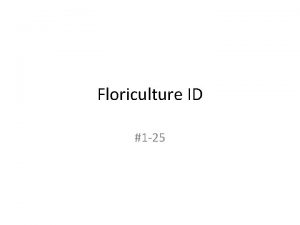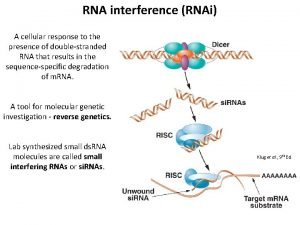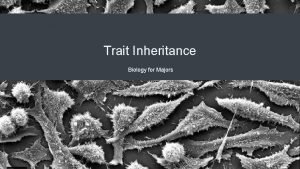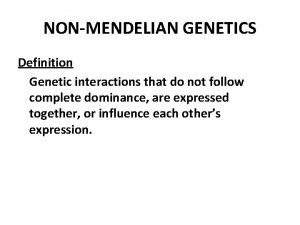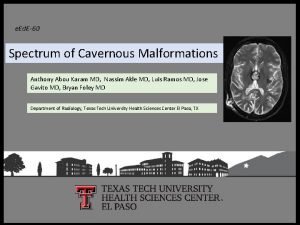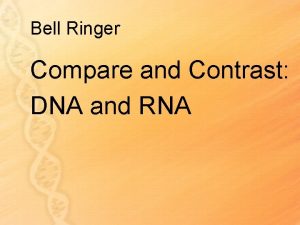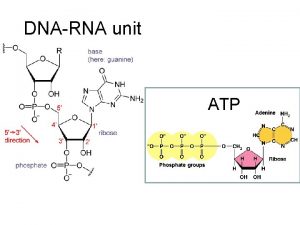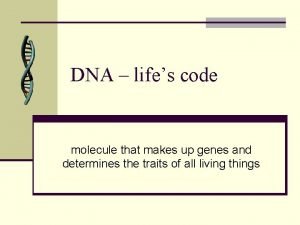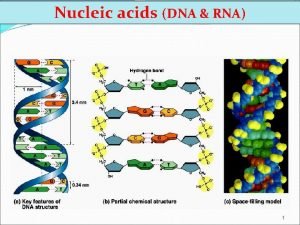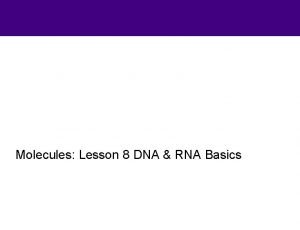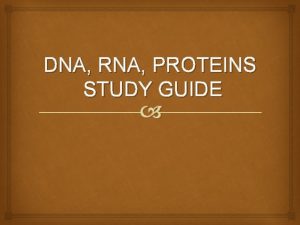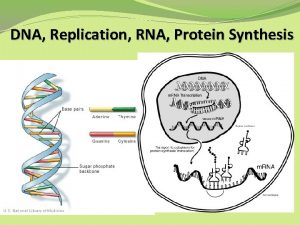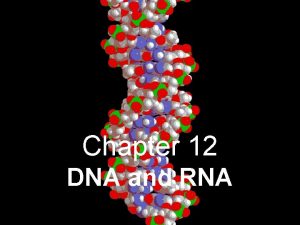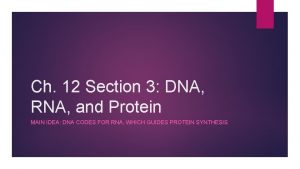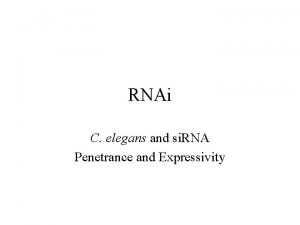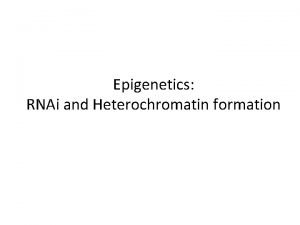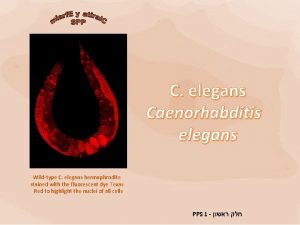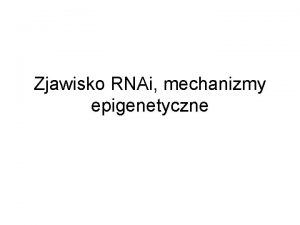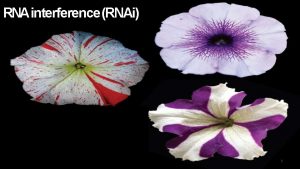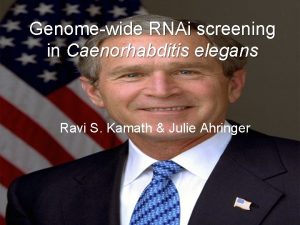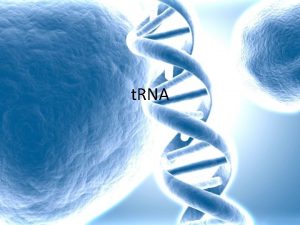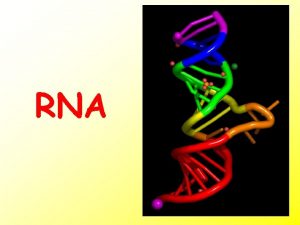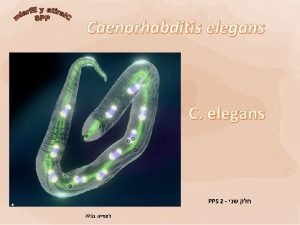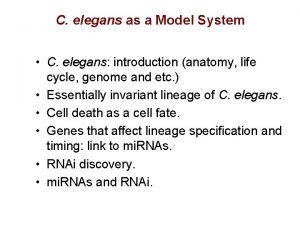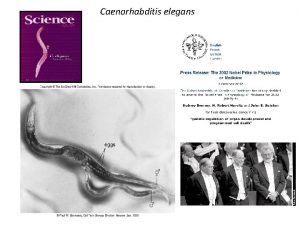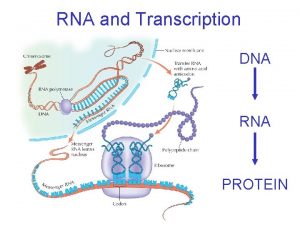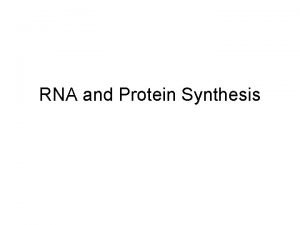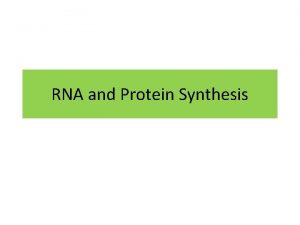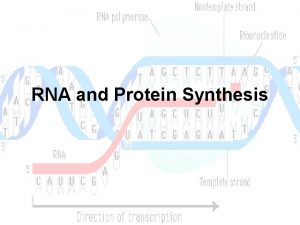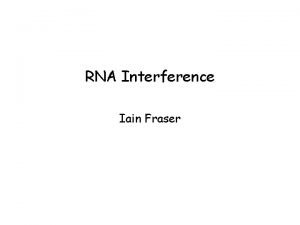RNAi C elegans and si RNA Penetrance and






















- Slides: 22

RNAi C. elegans and si. RNA Penetrance and Expressivity

Central Dogma addendum DNA transcription RNA Alt. Splicing Alt. Poly-A, Alt. Translation Start translation Protein Transcription Factors

Central Dogma addenda DNA TGS: Transcriptional Gene Silencing TGS transcription RNA PTGS Transcription Factors translation Protein PTGS: Post Transcriptional Gene Silencing

tiny RNAs (20 -to-25 nt RNAs) • in eukaryotic cells, tiny RNAs function as transcriptional regulators of gene expression in (at least) three distinct pathways, – (1) micro (mi. RNAs) regulate RNA translation. – (2) small interfering RNAs (si. RNAs) direct RNA destruction via the RNA interference (RNAi) pathway, • (3) and transcriptional regulation via epigenetic processes,

Ancient History (co-suppression) Transgene expression often decreases as the copy number of transgenes increased.

Co-suppression Modes. . . Transcriptional Gene Silencing (TGS), – RNA functions in the methylation of promoters and structural elements of genes, . . . Post-Transcritional Gene Silencing (PTGS), – involves the specific degradation of m. RNA via a double-stranded RNA intermediate, ds. RNA.

More Modern

RNAi RNA interference . . . while attempting to do anti-sense KO of gene expression in C. elegans, Guo and Kemphues, Cell 81, 611 (1995) observed that sense and antisense strands worked equally, – in an anti-sense experiment, a gene is constructed so that it produces a complementary strand to an expressed transcript, • the goal is to complement, thus inactivate the m. RNA. . following up, other researchers found that ds. RNA worked at least an order of magnitude better that either sense or anti-sense strands.

RNAi. . . si. RNA control of gene expression by RNA processing is now considered a common element in eukaryotic cells, – defense against viruses, – control of transposable elements, – regulate gene expression? …useful for doing Reverse Genetic studies, – ds. RNA triggers sequence specific degradation of complementary m. RNAs.

RNAi

delivery

C. Elegans and si. RNA • Bacteria expressing ds. RNA (via plasmid usually)… Isopropyl β-D-1 -thiogalactopyranoside Tetracycline: bacteria Ampicillin: plasmid (w/ds. RNA)

Genetic Stocks Blister Dumpy • E. Coli Strains: • HT 115(DE 3)/p. L 440(bli-1) - blister • HT 115(DE 3)p. L 440(dpy-11) - dumpy • HT 115(DE 3) - empty RNAi feeding vector (control) • C. elegans Strains: • dpy-11(e 224)V – Dumpy reference strain • bli-1(e 769)II – Blister reference strain • rrf-3(pk 1426)II – RNAi-sensitive worms

Penetrance …the frequency at which individuals with a given genotype manifest a specific phenotype.

Penetrance • 4 of 6 dogs, or 66% of the population shows the phenotype, at some level, • penetrance is usually referred to as a percentage. all the same genotype

Expressivity …the degree, or range in which a phenotype of a specific genotype is expressed.

Expressivity • range of phenotypes • expressivity may be referred to as a percentage, or another quantifiable measure. all the same genotype

Pentrance? Expressivity?

Pentrance? Expressivity?

Pentrance? Expressivity?

Pentrance? Expressivity?

To Do • Tuesday: – Old: score hfr plates, – New: plate worms on ds. RNA seeded plates, as well as plate controls, – Ongoing: Wasps.
 Adiantum spp. – maidenhair fern
Adiantum spp. – maidenhair fern Rnai
Rnai Ahringer rnai library
Ahringer rnai library Orchis elegans
Orchis elegans Complementary genes in sweet pea
Complementary genes in sweet pea Multiple alleles example
Multiple alleles example Pleiotropism definition
Pleiotropism definition Mva
Mva Compare and contrast dna and rna.
Compare and contrast dna and rna. Dna vs rna
Dna vs rna Section 12 3 rna and protein synthesis answers
Section 12 3 rna and protein synthesis answers Rna and atp
Rna and atp What is the goal of replication
What is the goal of replication Complete the following venn diagram
Complete the following venn diagram Dna and rna coloring worksheet
Dna and rna coloring worksheet Dna and rna
Dna and rna Phosphodiester bonds
Phosphodiester bonds Dna and rna
Dna and rna Dna rna and proteins study guide answers
Dna rna and proteins study guide answers Difference between dna and rna extraction
Difference between dna and rna extraction Dna and rna
Dna and rna Chapter 12 dna and rna
Chapter 12 dna and rna Chapter 12 section 3 dna rna and protein
Chapter 12 section 3 dna rna and protein
